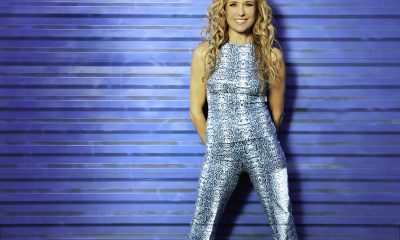Fashion
House of Fluff’s New Faux “Fur” and “Leather” Jackets Are Made Out of Plants
Spun from plant-based fibers and priced under $500, they’re the most accessible, sustainable, and mood-enhancing faux furs you’ll find this winter….



The real-versus-faux fur and leather debate has raged on for years, and there’s never been a clear-cut winner. The real stuff involves taking an animal’s life, a choice animal lovers refuse to make, and though they’re marketed as “natural,” fur and leather are often treated with chemicals or even plastic. Faux options, on the other hand, are typically made of polyester, which has its own environmental drawbacks: high-emissions manufacturing, micro-plastic shedding, and the fact that it’s made from oil (hence the term many have started using: “fracked fashion”).
Where’s the middle ground? Kym Canter, the founder of faux fur label House of Fluff, has spent the past three years thinking about what comes next. Since she couldn’t find a natural, animal-friendly option that worked for her price point, she partnered with a textile developer to create her own plant-based “fur.” With her new collection of trademarked BioFurs and “cactus leather” jackets, she’s joining the likes of Stella McCartney, who introduced a faux fur made of corn last year, and Reishi, an innovator in the mycelium “leather” space.
House of Fluff’s pieces are easily the most accessible and mood-enhancing: The BioFur hoodies, peacoats, and zip-ups are ultra-plush and come in a range of colors, from ivory and camel to lavender and an oddly soothing shade of cobalt—and they’re all under $500. Because Canter developed the textile (rather than purchasing it from a textile mill) and is selling the coats direct-to-consumer, there are no additional mark-ups. “If a lot of people can’t afford to share in these innovations, then what’s the point?” she says. “We want these to be easy to fit into your life.”
The BioFur is made from a top-secret corn polymer, but it does require a bit of recycled polyester to hold the fibers together. “Our ultimate goal is to use no polyester at all, and to become fully circular,” Canter says. In the meantime, she’s found an innovative “upstream solution” to deal with the potential microplastics: Canter described it as an additive that’s used in the beginning of the textile manufacturing process, so if one of the coats somehow ends up in a landfill or in the ocean, the additive “kicks in, and a chemical begins to eat away at the micro plastics,” she explains. “It acts like a natural fiber and completely decomposes. That, to me, is an absolute miracle.” None of her peers are using the technology yet, but it could be a promising fix for our dependence on synthetics, which now make up the bulk of our clothing.
Fashion
Raekwon Unveils “The Emperor’s New Clothes” With All-Star Lineup

Raekwon, a legendary rapper known for his role in the Wu-Tang Clan, has just announced his long-awaited eighth studio album, titled “The Emperor’s New Clothes,” set to be released through Mass Appeal. Although no singles have been shared yet, the album is already creating a buzz and is highly anticipated this summer. It’s been seven years since Raekwon last released a solo album, and this new project feels more like a grand return than just another release.
He’s teamed up with a mix of familiar faces from the Wu-Tang Clan and some fresh talent in hip-hop. Listeners can look forward to clever lyrics and captivating stories filled with raw emotion. Raekwon has invited his Wu-Tang brothers Ghostface Killah, Method Man, and Inspectah Deck to feature on the album, ensuring a classic blend that fans love. He’s also brought in well-respected artists outside of the Wu-Tang family, like Nas and members of the Griselda collective, Westside Gunn, Benny The Butcher, and Conway The Machine, who are known for their gritty style.
Adding to the variety, singers Stacy Barthe and Marsha Ambrosius will provide soulful vocals to complement Raekwon’s hard-hitting verses. The album’s production features talented names like Swizz Beatz, Nottz, J.U.S.T.I.C.E League, Frank G, and Roadsart, promising a rich, cinematic sound that matches Raekwon’s lyrical skills. Even with such an impressive lineup, there’s still a sense of mystery around the album. There have been no early songs or previews released, just the announcement itself, which builds even more expectation.
But for Raekwon, this is part of his journey. He has always delivered powerful lyrics and relatable street stories without much introduction. The title, The Emperor’s New Clothes, suggests a fresh start and a daring vision that might challenge the current state of rap. With his experienced flow and storytelling still sharp, Raekwon seems prepared to reestablish his place among the top artists in hip-hop.
Fashion
Wendy Williams Makes Stylish Splash At Columbia Supporting Her Designer

In a delightful surprise for fans and fashion enthusiasts, Wendy Williams made a rare appearance at Columbia University on Tuesday, and everyone couldn’t help but notice her. The former talk show host was in high spirits as she showed up to support her longtime friend and fashion designer, Mel Maxi. Wendy looked fantastic in a stylish black-and-white outfit that included a Yankee hat and her trademark flair.
Designed by Maxi himself, her outfit was not just chic but also had a personal touch that highlighted her vibrant personality. In a heartwarming moment recorded on video, Wendy told Maxi, “This is amazing! This was specifically designed for me… this is really hand done.” Wendy came to cheer on Maxi, who was set to give a lecture about fashion design at the prestigious university. Her appearance was a meaningful moment between two creative friends who have supported each other for years. Wendy’s presence emphasized the importance of friendship and collaboration in the creative world.
As she walked by, a nearby fan shouted their love for Wendy, and she instinctively responded with her signature warmth and enthusiasm: “Thank you!” she exclaimed with a big smile. After being away from the spotlight for months, Wendy’s visit was a refreshing change for fans who have missed her lively spirit. There were no fancy events or flashing cameras, just Wendy enjoying the moment, supporting a friend, and reminding us all of the significance of showing up for the people we care about.
-

 Artist Spotlight3 days ago
Artist Spotlight3 days agoHope Easton channels tropical mischief and charm in new single “SexyReady”
-

 Artist Spotlight3 days ago
Artist Spotlight3 days agoSweetCandy! declares self-love and defiance on “UGLY”
-

 Artist Spotlight3 days ago
Artist Spotlight3 days agoBluntBrad Jr. finds calm ambition in the laid-back shine of “It’s All Good”
-

 Artist Spotlight3 days ago
Artist Spotlight3 days agoLavien drops a heartfelt Afrofusion plea that sticks to the soul with “Nobody”
-

 Artist Spotlight2 days ago
Artist Spotlight2 days agoLana Crow turns challenges into a celebration with “Laugh With You”
-

 Artist Spotlight4 days ago
Artist Spotlight4 days agoCircleKSK ignites an anime-metal collision on “UnBreakable Turn” ft. Anya J
-

 Artist Spotlight4 days ago
Artist Spotlight4 days agoRecc explores nostalgia and inner freedom in “Where the Wild thYngs Are”
-

 Artist Spotlight4 days ago
Artist Spotlight4 days agoAnnaBelle Swift delivers gentle hope and gratitude with new single “Heaven Sent”

